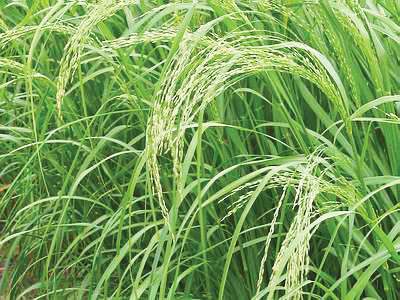Introducing Teff to TJC
Image: Teff grain (https://world-crops.com/tef/) Teff (Eragrostis tef) is a fast-growing grain that originated in Ethiopia. It produces the world’s smallest identified grain—roughly the size of a poppy seed with a test weight between 60 and 72 pounds per bushel—and is thought to be one of the first plants domesticated as a grain for human consumption, between 4,000 and 1,000 B.C.E. Teff has long been a staple food in Ethiopian cuisine where it is made into a fermented flatbread called injera, and more recently, teff has gained popularity outside Ethiopia as an alternative grain for its gluten free qualities. It has also been gaining the attention of agricultural researchers as a forage crop over the last few decades. As producers struggle to adapt to restricted water supplies, identifying high-value forage crops that will grow with limited water has become increasingly important. Due to its drought-tolerance, high biomass yields, and good nutritional profile, teff is growing in popularity with farmers. “Between 2005 and 2010, teff acreage in the US increased [from ~5,000] to more than 100,000 acres, based on encouraging research results in Oregon, New York, and elsewhere … Teff is typically higher in protein and forage quality than other common forage grasses. …teff compares favorably to other forage crops in its efficient use of water and fertilizer. Protein levels in teff hay are typically higher than common grass hay species, but are lower than alfalfa. However, teff requires less N fertilizer and irrigation water than comparable grass hay, and requires only about half the irrigation of alfalfa for optimum yields.” (Oregon State University) While all varieties of teff can be used as forage/biomass, some varieties are better for grain crops than others, and it is important to remember that there are different varieties that either give a good grain yield or a good biomass yield, and some that may be good for both. Given its long history with human agriculture and its adaptation to hot weather, arid conditions, and marginal soils, I am interested to see how different varieties of this multifaceted crop might fit into the biointensive models. Grown under optimal conditions, teff can reach maturity in 45-60 days. Teff has adapted to many different soil types, allowing it to do well in environments ranging from dry/arid areas to waterlogged soils. It has also been found growing in a wide range of altitudes from sea level to 9,186 feet. It is easily grown, and susceptible to few diseases, but does have a vulnerability to freezing (a soil temperature over 65°F is necessary for germination and optimal yields) which will limit the growing season in some regions. Teff is a self-pollinating annual grass that reaches about 2.5-3.5 feet at maturity and seems to do well at relatively close plant spacing, probably somewhere between 4-6 inch centers. My plan for this year’s Teff Project: When beginning research on a crop, I believe it is first
important to know its optimal growing conditions.
The existing conventional agricultural research indicates
that teff can be grown with different spacings
and in different times of the warm season; but
since we are uncertain of the best spacing and the
best timing for the GROW BIOINTENSIVE method of
close-spacing, those are the first things we should
research. This year, I plan to do four test plots of
25ft2, testing two different spacings at two different
timings. The two spacings will be 4-inch centers
and 6-inch centers, and the two different timings
will be started June 15th and July 15th. With a 45-60 day maturity, we should hopefully have our first
season’s results in August/September. I’ll let you
know what I find out in the fall! In the meantime,
if you’re interested in reading more about this tiny
but powerful plant, take a look at Teff Grass: Crop
Overview and Forage Production Guide.
♥ top | Newsletter Home |Table of Contents| Archive
|



